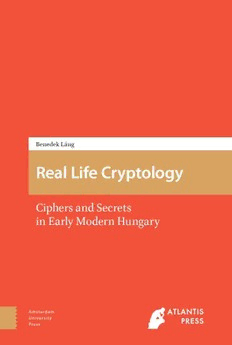
Real Life Cryptology: Ciphers And Secrets In Early Modern Hungary PDF
Preview Real Life Cryptology: Ciphers And Secrets In Early Modern Hungary
ATLANTIS STUDIES IN COMPUTATIONAL FINANCE AND FINANCIAL ENGINEERING B e n e d e k L á n g R e a Benedek Láng l L i f e C Real Life Cryptology r y p t o l o g y Ciphers and Secrets in Early Modern Hungary Real Life Cryptology Real Life Cryptology Ciphers and Secrets in Early Modern Hungary Benedek Láng Translated from Hungarian by Teodóra Király and Benedek Láng Atlantis Press | Amsterdam University Press Originally published as: ‘Titkosírás a kora újkori Magyarországon’ 2015, ISBN 9789635069514, Balassi Kiadó, Budapest Cover design: Coördesign, Leiden Lay-out: Newgen / Konvertus isbn 978 94 6298 554 4 e-isbn 978 90 4853 669 6 doi 10.5117/9789462985544 nur 685 Creative Commons License CC BY NC ND (http://creativecommons.org/licenses/by-nc-nd/3.0) B. Láng / Atlantis Press B.V. / Amsterdam University Press B.V., Amsterdam 2018 Some rights reserved. Without limiting the rights under copyright reserved above, any part of this book may be reproduced, stored in or introduced into a retrieval system, or transmitted, in any form or by any means (electronic, mechanical, photocopying, recording or otherwise). Table of contents Abbreviations 7 Note on terminology 9 Note on names 11 1. Introduction 13 2. U ncovered fields in the research literature 15 2.1. Neglected secret writings in secrecy studies 15 2.2. Secrecy in the history of science 18 2.3. The need for social history in cryptography studies 21 2.4. Cryptography in Hungary 25 3. Secret writings and attitudes – research questions 29 4. T heory and practice of cryptography in early modern Europe 31 4.1. Vulnerable ciphers: the monoalphabetic way 31 4.2. An Arabic contribution: the cryptanalysis 35 4.3. New methods in the literature: the polyalphabetic cipher 38 4.4. Practice in diplomacy: the homophonic cipher 43 5. C iphers in Hungary: the source material 51 5.1. Frameworks of data collection 51 5.2. General description of the sources 53 5.3. Cipher keys 56 5.3.1. The structure of the tables 56 5.3.2. L etters of the alphabet 69 5.3.3. The nomenclatures 72 5.3.4. Nullities 74 5.3.5. Grammatical elements 75 5.4. Encrypted messages 76 6. C iphers in action 85 6.1. Sharing the key 85 6.2. Replacing the cipherkeys 90 6.3. The tiresome work of enciphering 93 6.4. The cryptologist 94 6.5. Cautious and reckless encryption 95 6.6. Sand in the machine 99 6 REAL LIFE CRYPTOLOGY: CIPHERS AND SECRETS IN EARLY MODERN HUNGARY 6.7. Breaking the code 103 6.8. Advanced or outdated? 108 7. Ways of knowledge transfer 113 7.1. Handbooks of cryptography 115 7.2. Artificial languages 122 7.3. Stenography 124 7.4. The Turkish factor 125 7.5. Distance from diplomacy 129 8. Scenes of secrecy 131 8.1. Dissimulation and the secret 131 8.2. Communication in politics 133 8.3. Military operations and espionage 146 8.4. Love, politics and male bonding 149 8.5. Family secrets and privacy: ladies and ciphers 155 8.6. Private sins – public morals: secrets of a diary and shame 157 8.7. Science, chemistry and alchemy 161 8.8. Secret characters and magic 167 8.9. Encrypting in religion 169 9. Summary 179 10. Appendix 183 10.1. List of cipher tables from early modern Hungary 183 10.2. List of ciphertexts from early modern Hungary 191 Acknowledgements 207 Earlier publications 209 Bibliography 211 Index 221 Abbreviations AR Archivum Rákóczianum, II Rákóczi Ferenc levéltára (Rákóczi Archives) (Budapest: MTA Tört Biz. Kiad. 1873–1935) vols. 1–12. ÖStA HHStA Ö sterreichisches Staatsarchiv, Haus-, Hof- und Staatsarchiv, Vienna MNL OL M agyar Nemzeti Levéltár, Országos Levéltar, Budapest (Hungarian National Archives, Budapest) MTT Magyar Történelmi Tár (Hungarian Historical Records), (Pest, Magyar Tudományos Akadémia, 1855–1934) OSZK O rszágos Széchényi Könyvtár (National Széchényi Library) Teleki Teleki Mihály Levelezése (Correspondence of Mihály Teleki) (Budapest: Magyar Történelmi Társulat, 1905–1926), vols. 1–8. Note on terminology In theory, cryptology is a discipline composed of two fields, cryptography, that is secret writing, and cryptanalysis, that is codebreaking (cryptanalysis is a modern term forged by William Friedman). In the period under study, no such methodical distinction was used, ciphering, encryption, “translat- ing”, “working with chiffres” and many other terms are applied somewhat inconclusively in the sources. Therefore, throughout the book, differentia- tion between cryptology and cryptography will be neither systematic nor analytic. Whenever I refer to the practice of ciphering in general, I will use cryptography, unless I want to particularly emphasize that besides encryp- tion, codebreaking is also included in the activity, because then I will use cryptology. All other terms – open text, plain text, monoalphabetic, homophonic, and polyalphabetic ciphers, frequency analysis, probable word method, en- tropy, etc. – will be explained in the book at their first occurrences.
